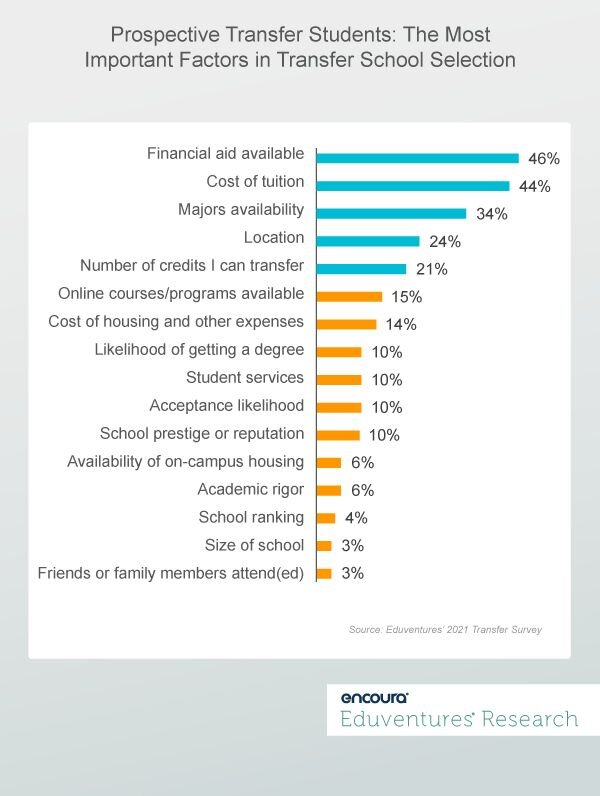Transfer students are notoriously pragmatic. Eduventures’ research has continuously shown that transfer prospects weigh practical factors when considering a transfer destination: availability of financial aid, cost of tuition, and availability of their chosen majors are consistently the top criteria.
On paper, these students resemble homo economicus, those who make decisions solely based on rationality and self-interest. But the concept of homo economicus has been debunked. Humans are inherently irrational beings. Therefore, perhaps there is more to the decision making of transfer students than these students are willing to admit?
Figure 1, based on Eduventures’ Transfer Student Research™, shows that three of the top five factors influencing transfer school selection involve cost either directly or indirectly, such as financial aid availability and the “number of credits I can transfer.”
Figure 1.
Figure 1 also reveals that, early in the enrollment funnel, academic strength—rankings, reputation, or perceived rigor—does not seem to matter nearly as much as cost and other practical considerations like availability of desired major and location. At face value, transfer prospects agree that they are indeed pragmatic customers.
But once these students apply and are accepted to transfer schools that meet their criteria, do their enrollment choices really come down to which schools will be the cheapest to attend?
According to our Admitted Student Research™, this might not be the case. Table 1 shows the percentage of transfer students who rated their enrollment choices and their next closest alternative choices as either “very good” or “excellent” on seven enrollment drivers.
Admitted Transfer Students: Quality Ratings of Enrolling Transfer School and Alternative Choice
| Enrollment Driver | Percent of “Very Good” or “Excellent” Ratings | Gap Between Enrollment School and Alternative Choice | |
|---|---|---|---|
| Transfer Enrolling School | Transfer Alternative Choice | ||
| Core Academics | 87% | 90% | -3 |
| Diversity of Academic Opportunities | 83% | 78% | 5 |
| Career Outcomes | 83% | 87% | -4 |
| Social Environment | 82% | 78% | 4 |
| Physical Environment | 81% | 77% | 4 |
| Academic Environment | 77% | 77% | - |
| Affordability | 47% | 58% | -11 |
Table 1
Table 1 shows that when it comes down to the final enrollment decision, transfer students rate their enrollment schools highest on core academics (e.g., perceived strength in program of interest, quality of faculty, etc.), but, surprisingly, not as highly as their alternative choices (87% vs. 90%).
Also a head-scratcher: transfer students rate their alternative choices more highly on career outcomes (83% vs. 87%), and … wait for it … affordability! In fact, they rate their alternative choices higher on affordability by 11 percentage points.
In other words, many admitted transfer students believe that the next best alternative schools they applied to offered better affordability than the schools they ultimately chose. How could that be?
A likely explanation is that they only applied to more affordable schools in the first place and so when they ultimately chose between them, this was no longer the most important criterion. We know, for example, that about 69% of transfer prospects believe they will attend a public institution in their home state—the most economical option—vs. 42% of traditional prospects. This explanation likely applies to both major availability and career outcomes as well.
Instead, admitted transfer students only rate their enrollment schools higher on diversity of academic opportunities (+5 percentage points), the social environment (+4 percentage points), and the physical environment (+4 percentage points). These are all factors that aren’t very important at the prospect stage but seem to tip the enrollment decision in favor of one school over another.
The Bottom Line
This data suggests that when it comes down to final college choice, transfer students are just as irrational as the rest of the human species. So, should we simply not believe them when they tell us about their very practical transfer school criteria?
Not at all. Similar to traditional students who seem to get more practical as they move through the enrollment funnel, transfer students may also focus on certain criteria at the prospect stage and other criteria at the admit stage. They form their application lists with highly practical considerations like cost and major availability. But when the cost seems doable and the desired academics are available, even transfer students will turn their attentions to secondary, but nonetheless also important factors: Will I be happy on campus? Will I find my people?
Recruiters need to be prepared to address these concerns as well—at the right time in the funnel—even for transfer students.


